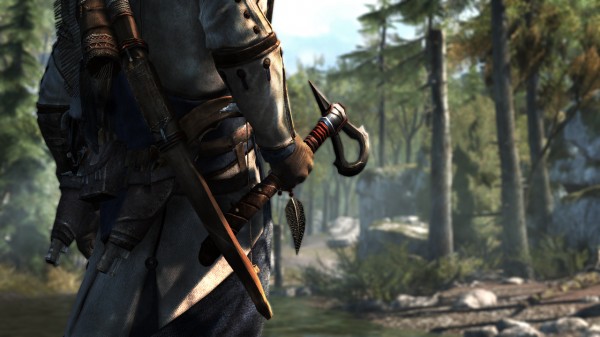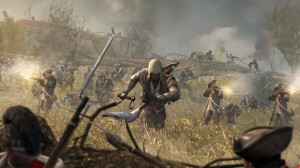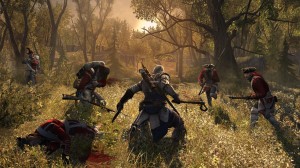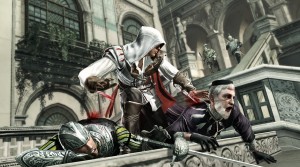Connor is a Terrible Man
- Updated: 7th Jan, 2013

There are two Connors in Assassin’s Creed 3 depending on how you choose to play the game – one is good, one is bad, and both of them are terrible.
It all comes down to the side missions, really – there’s very little reward for playing them, whether that’s story-based or mechanical. There’s not the blistering heat of discovery that we found with The Truth in Assassin’s Creed 2, nor the meaningful upgrades of health and weapons we received in the rest of the series. Whether you complete the missions is largely up to whether you, as a player, want to do so.
And from that, you get two vastly different readings of our hero.
Nice Guy Connor
If you choose to complete the side-missions, you establish Connor as an unwilling Assassin – an Assassin in name only, a confused boy on a confusing quest – who just wants to forge a community after endangering and being exiled from his own. He lost his mother at an early age and he spends the game searching for father figures that he never finds. His attempts at bonding with others are stilted at best thanks to his dual heritage, so he resorts to making new, safe spaces.
 He liberates the fledgling cities of New York and Boston. He builds a homestead from very little and watches it grow and flourish into a living, breathing thing by helping the inhabitants in any way he can – setting up dates, playing bowls, herding pigs, fetching doctors, and breaking up fights. He collects almanac pages and feathers and talks to hunters and couriers letters and delivers packages of dolls and hair accessories and buttons to quiet, unassuming men in back streets because he is desperately trying to be a nice guy and he just can’t win.
He liberates the fledgling cities of New York and Boston. He builds a homestead from very little and watches it grow and flourish into a living, breathing thing by helping the inhabitants in any way he can – setting up dates, playing bowls, herding pigs, fetching doctors, and breaking up fights. He collects almanac pages and feathers and talks to hunters and couriers letters and delivers packages of dolls and hair accessories and buttons to quiet, unassuming men in back streets because he is desperately trying to be a nice guy and he just can’t win.
Occasionally, he’s asked to kill people. He doesn’t seem to enjoy it much, or fully understand why he’s doing it. Later in the game – once he’s decided that liberating the entire country is something he wants to do, which is community-building on a grand scale if you squint – he grows angry with Achilles because he’s forbidden from joining up with the Templars to make everything easier.
Connor – the de facto head of the Assassin’s guild in America – wants to join the Templars. This isn’t the burning fire of Ezio’s revenge, or the cold proficiency of Altaïr. It is a disorentated young man with no direction shirking off his “job” as an Assassin and trying to make a new home to replace the one he lost. And it’s not working. There’s no end in mind. At one point he asks what will happen when he “wins,” and whether there’s peace to be found in that. And you know there’s not.
Scumbag Connor
The other Connor, though, is accessed by not doing any of the side missions. And it’s easy not to do them, too. If you flash through the main missions and disregard everything else, Connor is a lunatic.
 After receiving a vague suggestion from a mysterious glowing eagle, he staggers out into the world and immediately starts killing people if they so much as look at him funny – remember back to the first few minutes outside of his home camp, where enemy guards seem very keen on shooting at him for reasons that are never made clear.
After receiving a vague suggestion from a mysterious glowing eagle, he staggers out into the world and immediately starts killing people if they so much as look at him funny – remember back to the first few minutes outside of his home camp, where enemy guards seem very keen on shooting at him for reasons that are never made clear.
He walks through miles and miles of wilderness to meet an ageing murderer who lives in the woods in a massive crumbling house, and swears allegiance to him in exchange for being taught the arts of murder.
And he kills people. He travels to the centre of cities for reasons that he can barely remember or even understand, thanks to the game’s poor explanation of what’s going on and why it’s happening at any given moment, and he kills men. Mainly he kills soldiers because they are looking at him; occasionally, very rarely, he kills someone that matters. And then he flees back to the crumbling house in the woods to await his next assignment.
All around him, people need help. Families are abused and evicted; his homestead, made up of two wood-choppers and some homeless girl he found in the forest, is neglected and leaderless. There is an accounting ledger he has opened precisely once and and subsequently ignored. He – and the player, too – doesn’t care.
His pockets are lined with the detritus of his animal kills as a boy; wet, uncured beaver skin, rotting deer meat, a collection of teeth and claws, a pocketful of bear fat. He has carried it around with him for years and years. He stinks. Guard dogs smell him from a street away and start barking.
In the basement of the crumbling house in the woods is there is a hidden room, and it contains wide stone floors and large empty shelves where weapons and clothes should be. There is a bloodstained stone axe on one wall, next to a vicious-looking snare that Connor used to hunt animals once but now never touches.
There is plenty of space for different outfits that he could wear, but the only alternate option is a set of bloodstained rags he wore in prison. (I can’t recommend enough that you wear these if you choose to ignore the side-missions, for the full effect.)
In this reading, Connor is equally directionless and confused, but he’s dangerous with it. Ezio has ends in mind to justify his means, and Altaïr burns with a monastic devotion to the difficult life he has chosen to lead – even if it’s a devotion enforced through punishment.
 Connor, though, hides himself away from society in an underground cave and uses strange technology given to him by a well-meaning but stern elderly black man.
Connor, though, hides himself away from society in an underground cave and uses strange technology given to him by a well-meaning but stern elderly black man.
He has a vague sense, a quest even, to stop Bad Men after Bad Men meant he didn’t have a mother or a father growing up, but more often than solving the problem he just ends up knocking the tar out of underlings. He solves none of his problems. He is striving to solve an unsolvable problem. He is a crusader for Freedom and Justice and all sorts of big words that he doesn’t even really understand, a blade in the darkness, a shadow on the rooftops, a fighter for people he’s never met and doesn’t want to.
He is Batman.
He is Batman with no money and no qualms against killing, no veneer of civility to retreat to, no Bruce Wayne to compartmentalise his feelings. He is a bloodstained lunatic who hangs men from trees by their necks and kills ten men over the sake of a trespassing dispute. He is a terrorist.
Is This Good, Then?
It’s an interesting way of looking at the game, for sure, much in the same way you can play Deus Ex: Human Revolutions as the mythical aug who flips out and kills everyone and stalks the bloody streets, just like the protesters in Detroit warned each other about as they sprayed graffiti on walls or warmed their hands round oil-can fires.
Or the way you can view 50 Cent: Blood on the Sand as a daydream in the head of DJ Whoo Kid, one of the supporting characters, a by-product of his unquestioned worship for Fiddy.
 But you couldn’t write an article like this about the previous Assassin’s Creed games, as the characters within were clearly-defined enough (if not especially deeply, in Altaïr’s case) not to allow it. Their motives aligned at least partially with their actions.
But you couldn’t write an article like this about the previous Assassin’s Creed games, as the characters within were clearly-defined enough (if not especially deeply, in Altaïr’s case) not to allow it. Their motives aligned at least partially with their actions.
There’s a disconnect throughout the game where the fun is repeatedly kept at arms’ length from the player through poor communication and misstep after misstep; and the story, and these readings of it, are part of that.
But tell me you can’t imagine Connor crouching in the basement, dressed in filthy rags, waiting for nothing but his next mission. And tell me that doesn’t make the game much, much better.

Pingback: The Time Machine: Where Assassin’s Creed 3 Went Wrong | Benjamin 'Games' Rose